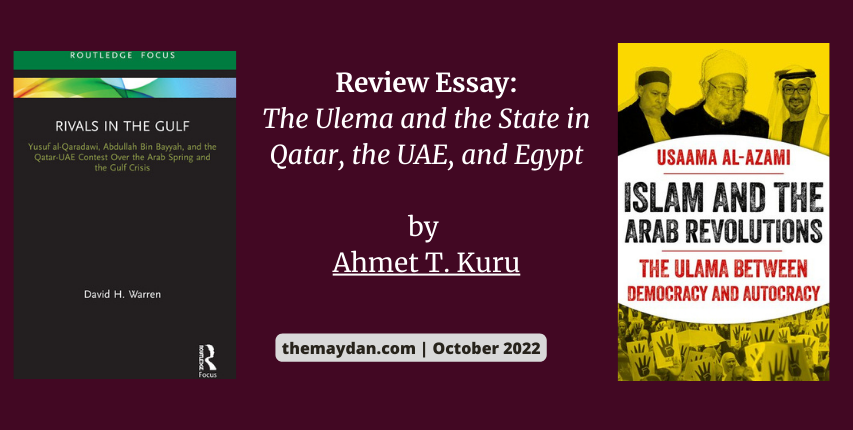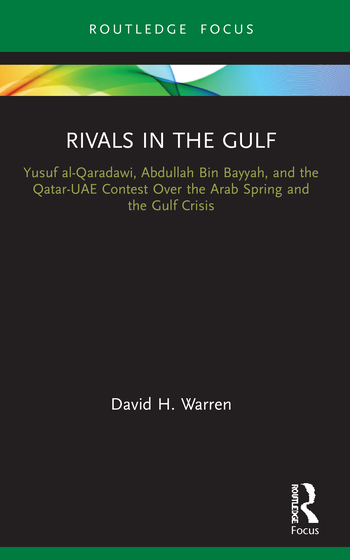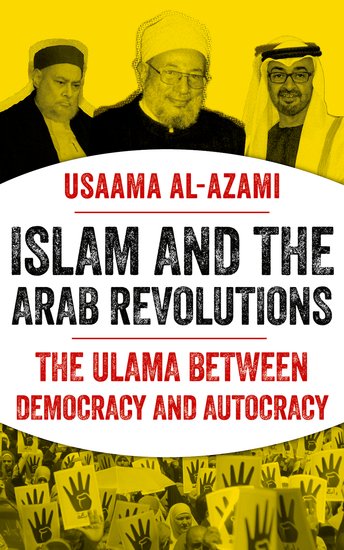
David H. Warren, Rivals in the Gulf: Yusuf al-Qaradawi, Abdullah Bin Bayyah, and the Qatar-UAE Contest Over the Arab Spring and the Gulf Crisis. Routledge, 2021. 130 pp. Paperback: $18.
Usaama al-Azami, Islam and the Arab Revolutions: The Ulama Between Democracy and Autocracy. Oxford University Press, 2022. 376 pp. Hardcover: $70.
In September 2012, the euphoria of the Arab Spring was still continuing in the region. My wife and I decided to spend the 2012-2013 academic year in Qatar for research, and our son was born in Doha. While there, I also conducted interviews in Egypt and Tunisia. The Arab Spring seemed to be in full bloom. Then, a few days after we returned to the United States, the July 2013 military coup changed the political scene in Egypt one more time. Since then, Tunisia remained “the only democracy the Arab Spring produced,” but that too was destroyed by a recent presidential coup.
The failure of the Arab Spring is a complex phenomenon, which requires the analysis of multiple factors, including social, economic, and international variables in about a dozen countries. Of these, a crucial factor is the politics of Islam, and more specifically, the role of Muslim scholars (ulema) and their relations with state actors. Two new books successfully examine that factor across three key countries.
David H. Warren’s Rivals in the Gulf focuses on the rivalry between Qatar (which hosted Yusuf al-Qaradawi) and the United Arab Emirates (UAE) (which cooperates with Abdullah Bin Bayyah). Qaradawi was born in Egypt (1926), where he graduated from al-Azhar and was targeted by the state for being a member of the Muslim Brotherhood (MB). He received Qatari citizenship in 1968 and remained based there up until his recent passing. Bin Bayyah was born in Mauritania, where he served as minister of justice and minister of education. Although he and the UAE rulers became close allies recently, their relations have a long history.

Warren emphasizes how these two scholars worked closely until the Arab Spring. Qaradawi was the head of the Qatar-based International Union of Muslim Scholars (IUMS) and Bin Bayyah was his deputy starting in 2004. These two scholars were together defending traditional Sunni teachings even though they had their differences: Bin Bayyah was a Sufi while Qaradawi was a MB affiliate (he was offered but declined the position of MB’s General Guide twice).
The Tunisian Revolution began in December of 2010 and inspired the Egyptian Revolution a month later. Qaradawi became the leading scholar and Qatar became the most enthusiastic state supporting revolutions across various Arab countries. Their main pro-revolution platform was al-Jazeera TV. In his popular show “Sharia and Life,” Qaradawi issued fatwas to encourage the deposition of certain Arab regimes. At the time, Bin Bayyah kept a much lower profile and used a more cautious language.
Until June 2013, Qaradawi, Qatar, and the platforms they espoused seemed on the rise. When Qaradawi visited post-revolution Egypt, Warren notes that he was compared to Khomeini:
The image of an alim returning from exile following a revolution led to inevitable comparisons with the 1979 Iranian Revolution, and Qaradawi was soon given the label of “the Egyptian Khomeini.” While Qaradawi’s return was praised in some quarters of the Egyptian media, it was criticized by others, as part of an MB [and al-Jazeera] effort to hijack the Revolution (44).
But this was a short-lived victory, as Warren points out. On June 25, 2013, the Emir of Qatar, Hamad bin Khalifa Al Thani abdicated in favor of his son, Tamim bin Hamad, who was not as enthusiastic as his father in supporting revolutionaries. On July 3, the Egyptian armed forces led by General Abdel Fattah al-Sisi staged a coup against President Mohammed Morsi, an MB member and Egypt’s only elected president, around the first anniversary of his election.
After these events, Qatar was put under increasing pressure from its neighbors, especially the UAE and Saudi Arabia, the two main financial supporters of the Sisi regime. These neighbors had a list of drastic demands for Qatar, including the closure of al-Jazeera and the extradition of Qaradawi, who was sentenced to death in absentia in Egypt, alongside with Morsi and over a hundred other MB members. Qatar did not accept either of these two demands but “disciplined Qaradawi by removing him from his platforms and publicly hinting at his possible deportation” (116).
Warren concludes that with this decline in Qatar’s political capital, the UAE was ambitious to fill the resultant vacuum. So was Bin Bayyah, who formally put distance between himself and Qaradawi—two months after the Egyptian coup–by resigning from IUMS. In March 2014, the UAE established an alternative ulema organization: the Forum for Promoting Peace in Muslim Societies (FPPMS). Bin Bayyah became its head and his former student Hamza Yusuf, a well-known American scholar, became his deputy.
Warren’s book successfully examines political events, religious ideas, and the connection between the two. It is a rare work combining complex analysis of certain ulema’s Islamic interpretations with an engaging narrative of political processes. I wish the book had been longer…
There were certain theoretical questions in my mind while reading Warren’s work. Primary amongst these was the issue of ulema-state relations. Some critics of my recent book’s emphasis on the ulema-state alliance depicted the ulema as mere servants of the state; for the critics, there is no alliance, but only the ulema’s subservience to the authoritarian state. Warren’s analysis, however, shows that relations between the ulema and the state are symbiotic and even mutually constitutive. In his words, the “decades-long relationships between these two ulama and these two families”—the ruling families of Qatar and the UAE—cannot be simply defined as state co-optation, “[r]ather these two ulama have shaped…[the two families’] ideologies and their visions for the region” (115). For example, the UAE’s ruling family echoes Bin Bayyah’s “description of the crisis of Islamic authority as ‘the chaos in religious discourse,’ which leads to violence” that “necessitates the intervention of powerful states to support the ulama by, for example, creating new state-institutions for training muftis” (116).
Warren also emphasizes certain differences between particular ulema-state alliances in the two states: “In 2018, the UAE differentiated itself from Qatar when it established an official state-backed fatwa council” (110). This indicates a variation between the frameworks the two scholars used in their political interactions: “In accepting the position of President of the Council, Bin Bayyah argued, ‘It is necessary for the state to intervene in order to take the fatwa out of the hands of terrorists and extremists.’ While Qaradawi attenuated his relationship with the Qatari state for fear it may compromise his claim to authority, for Bin Bayyah state sponsorship is something to be courted and celebrated” (110).
Warren’s book successfully examines political events, religious ideas, and the connection between the two. It is a rare work combining complex analysis of certain ulema’s Islamic interpretations with an engaging narrative of political processes. I wish the book had been longer, but Warren has decided to postpone the analysis of Egypt into a new book. Fortunately, another scholar, Usaama al-Azami, has recently published a longer book on the same topic, which also covers Egypt. The rest of the essay will primarily focus on Azami’s book, circling back to Warren’s work for a concluding comparison.
 The subtitle of Azami’s book, The Ulama Between Democracy and Autocracy, summarizes its main argument. When discussing pro-democracy ulema, Azami primarily analyzes Qaradawi and explains in detail how Qaradawi promoted Arab revolutions by interpreting Quranic verses and hadiths to develop a “Jurisprudence of Revolution.” For example, Qaradawi defined Tunisian Revolution as a “jihad,” justified the self-immolation of Bouazizi (which ignited the Revolution) as having an Islamic legal excuse (thus, not committing a condemned suicide), and issued a fatwa calling for Gaddafi’s killing (19-21, 294). Qaradawi also compared dictators in Egypt and some other Arab countries to the infamous Pharaoh denounced in the Quran (44-46).
The subtitle of Azami’s book, The Ulama Between Democracy and Autocracy, summarizes its main argument. When discussing pro-democracy ulema, Azami primarily analyzes Qaradawi and explains in detail how Qaradawi promoted Arab revolutions by interpreting Quranic verses and hadiths to develop a “Jurisprudence of Revolution.” For example, Qaradawi defined Tunisian Revolution as a “jihad,” justified the self-immolation of Bouazizi (which ignited the Revolution) as having an Islamic legal excuse (thus, not committing a condemned suicide), and issued a fatwa calling for Gaddafi’s killing (19-21, 294). Qaradawi also compared dictators in Egypt and some other Arab countries to the infamous Pharaoh denounced in the Quran (44-46).
In Azami’s categorization, the counter-revolutionary ulema were pro-autocracy. Authoritarian regimes, especially in Egypt, “carefully cultivated a class of what we can refer to, adapting Qaradawi’s usage, as ulama al-sultan—scholars at the service of state authority” (241). The paramount example of the pro-autocracy ulema is Ali Gomaa, the Grand Mufti of Egypt (2003-2013). The Grand Mufti serves as the head of Dar al-Ifta, a governmental Islamic advisory agency which issues non-binding fatwas daily for both Egyptian state institutions and Muslim individuals, on many issues from death sentences to worship details. Hence, Gomaa was the second most influential alim in Egypt after Ahmad al-Tayyib, the Shaykh of al-Azhar (2010-present).
Both Tayyib and Gomaa were appointed to these positions by President Hosni Mubarak. In fact, Tayyib was even a member of Mubarak’s ruling National Democratic Party when he was appointed. Both Tayyib and Gomaa opposed the 2011 Revolution and supported the 2013 military coup. There was, however, a difference between them. While supporting the coup, Tayyib defined it as “the lesser of two evils” (127). Since the coup, “Tayyib’s resistance to entirely assimilate the kind of statism that Gomaa would exemplify created rifts between himself and Sisi” (244).
Azami explains that Gomaa not only ardently supported the coup but also legitimatized the military violence against MB members. Azami holds Gomaa particularly responsible for justifying the Rabaa massacre to the extent that his detailed and repeated explanations on this issue can be defined as the core of the book. The massacre took place on August 14, 2013, when security forces violently cleared tens of thousands of anti-coup protestors from a sit-in at Cairo’s Rabaa Square by killing over a thousand protestors. Despite the military regime’s initial claim that the protestors were armed, the interior minister later stated that “only fifteen guns had been found” belonging to them (140).
Gomaa gave two lectures recorded by a military agency to show security forces—one before and the other after the Rabaa massacre. Both recordings became public a few months later. In these lectures, Gomaa provided “religious justification to the killing of anti-coup protestors whom he portrayed as armed rebels threatening Egypt as a whole.” Gomaa “also gave Friday sermons to the armed forces with Sisi in attendance…in praise of the Egyptian army” (128). Gomaa’s lectures included inflammatory phrases such as killing the “dogs of Hellfire” and they implicitly demonized MB members. The video recordings of his lectures received international criticism, including from the New York Times; in response, Gomaa simply denied the main messages of his lectures.
Gomaa’s pro-military attitude was rewarded by the Sisi regime who gave him “control over the MB’s massive Islamic Medical Association” which had been seized after the coup (174). The new Grand Mufti, Shawqi Allam (2013-present) has also had a hostile attitude against the MB, using social media, among other avenues, to disparage them. Not all Azhari scholars were like Gomaa and Allam; Azami explains how two other Azhari scholars–Hasan al-Shafi and Muhammad Imara–opposed the coup and its military violence.
Like Warren, Azami also surveys the attitudes of Bin Bayyah and Hamza Yusuf—two non-Azhari scholars—and categorizes them as pro-authoritarian. Azami explains how Bin Bayyah and Yusuf have worked with Muhammed bin Zayed—“the main driving force behind the Arab counter-revolutions” (99)—who recently became the president of the UAE. In 2020, Bin Bayyah “fully aligned himself” with the UAE government’s designation of the MB members as terrorists by issuing “a statement in the name of the Emirates Fatwa Council” (239).
Yusuf also became a leading member of the Emirates Fatwa Council. For Azami, Yusuf’s close collaboration with the UAE monarchy fits his political views, because “[i]n Yusuf’s opinion, there was something inherently noble about monarchy” (93-94). Azami quotes Yusuf’s interviews where he claims that “kings are incorruptible unlike those who do not possess great wealth” and appreciate monarchs’ ability to make “quick and decisive decision” (103, 105).
Azami’s book is very informative and meticulously written. It is a must read for anyone interested in contemporary ulema’s political views, particularly in the crucial case of Egypt during the rise and fall of the Arab Spring. My main critique is the book’s presentation of Qaradawi as a leading example of pro-democracy ulema.
Azami’s book is very informative and meticulously written. It is a must read for anyone interested in contemporary ulema’s political views, particularly in the crucial case of Egypt during the rise and fall of the Arab Spring. My main critique is the book’s presentation of Qaradawi as a leading example of pro-democracy ulema. Azami defines Qaradawi as “a committed democrat, who alongside other Islamists had spent much of his later career developing an influential Islamic conception of democracy” (185).
Azami acknowledges some limits of Qaradawi’s pro-revolutionary stance. He mentions Qaradawi’s lack of support for the protests in Shii-majority but Sunni-ruled Bahrain (36, 248). On this issue, however, Warren is much more forthright: “In Bahrain, Qatari police joined the UAE and Saudi Arabia to crush the protests…Qaradawi’s own interventions in the Bahraini…context were in accordance with Qatari foreign policy…[H]e repeated the narrative produced by state-run media in the Gulf states that the Bahraini uprising was violent, sectarian, and an Iranian plot” (48; see also 49-51).
A more important theoretical problem is the limits of Qaradawi’s understanding of democracy. When Qaradawi refers to democracy he is basically speaking of majority rule so long as the majority follows his notion of Islam, particularly Islamic law. Azami does emphasize that Qaradawi is not a defender of “liberal” democracy (60). This is correct but insufficient. Qaradawi ignores democracy’s minimum requirements such as freedom of speech, including freedom of expressing religious views without being killed. Qaradawi defends the capital punishment for apostates. For him and many other classical ulema, a self-defined Muslim can be declared as an apostate if she deviates from orthodox teachings—for example, if she declares something like drinking beer “halal” while the ulema by consensus declare it “haram.” Hence, the rule of killing an apostate is not only a punishment for those who leave Islam, but also a barrier to self-avowed Muslims’ expressions of reformist ideas.
In a broader sense, Qaradawi does not address the tensions between democracy, a system where the people and their representatives make laws by popular vote and public discussions based on current needs, and sharia-based governance, a system where the ulema make laws based on their understandings of sacred texts. These tensions lead to many other questions, such as how to provide equal citizenship to non-Muslims in a sharia-based system.
Of relevance here is Khaled Abou El Fadl’s critique of Qaradawi in 2004:
Qaradawi…only has the most superficial and casual knowledge of the institutions and theories of democracy. As a result, in his writings, Qaradawi treats democracy basically as an institution that gives effect to the will of the majority. Since Qaradawi assumes that the majority of the citizenry of an Islamic state will be Muslim, he does not foresee any problems with applying Shari‘ah law in a democratic state.
Having read this in 2004, I was hoping that after the eighteen-year interim, I would now be able to find new views of Qaradawi that taken into account El Fadl’s critique, but I simply did not see them in Azami’s book.
On the other hand, Warren’s book does quote El Fadl’s critique and further stresses that “as the Arab Spring unfolds and reveals deep divisions in Arab societies, it becomes increasingly clear that [Qaradawi’s] understanding of democracy is ill-suited to the complicated realities of democratic politics” (33). Warren also notes the tension between democracy and the ulema as the guardian of sharia: “For [Qaradawi], though the people may choose their rulers, they may not choose to forbid that which Islam has permitted or permit that which Islam has forbidden. Consequently, they remain in need of the ulama to maintain those boundaries” (33).
In sum, Rivals in the Gulf and Islam and the Arab Revolutions are two insightful books which analyze such crucial subjects as the religio-political competition in the Gulf and the religious justifications of state violence in Egypt. These two books complement each other and together provide a stunningly detailed analysis of the ulema-state relations in the contemporary Middle East.
Ahmet T. Kuru is Professor of Political Science and the director of Center for Islamic and Arabic Studies at San Diego State University. He is the author of award-winning Secularism and State Policies toward Religion: The United States, France, and Turkey (Cambridge UP, 2009). His 2019 book, Islam, Authoritarianism, and Underdevelopment: A Global and Historical Comparison (Cambridge UP) received the American Political Science Association’s International History and Politics Section Award. His works have been translated into Arabic, Bosnian, Chinese, French, Indonesian, Malay, Persian, and Turkish.

